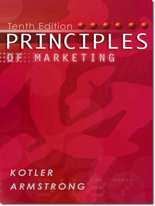|
| |
|

Roger A. Kerin
Eric N. Berkowitz
Steven W. Hartley
William Rudelius
Dynamic... Exciting... Challenging... and Surprising!
The 21st century is an extraordinary time for instructors, students, and
managers to be involved in the field of marketing. Virtual advertising,
multi-channel retailing, eCRM, cashless vending, everyday fair pricing, online
coupons, data mining, and brand equity are just a few of the many indications
that marketing is racing into a new era. At the same time, many traditional
elements of the discipline such as segmentation, new product development, and
pricing are growing in importance and use. The combination of the contemporary
and the traditional elements of marketing create a truly exceptional topic to
study and understand. We appreciate the opportunity to share our enthusiasm for
the field with you and welcome you to your introduction to marketing!..more
Our Site
The 3 Books
Link |

|

Our
Site
Please also see
Principles Of Marketing (9th Edition) by Kotler & Armstrong
Metatext Edition include Preface & CHAPTER 4
MARKETING RESEARCH AND INFORMATION SYSTEMS (Course). Please visit
Companion Website
In order to produce superior value and satisfaction for customers,
companies need information at almost every turn. Good products and
marketing programs begin with a thorough understanding of consumer needs
and wants. Companies also need an abundance of information on competitors,
resellers, and other actors and forces in the marketplace.
Increasingly, marketers are viewing information not just as an input for
making better decisions but also as an important strategic asset and marketing
tool. In today's marketing, a company's information may prove to be its chief
competitive advantage. Competitors can copy each other's equipment, products,
and procedures, but they cannot duplicate the company's information and
intellectual capital. Several companies have recently recognized this by
appointing vice presidents of knowledge, learning, or intellectual capital.
|
|
Marketing (12th Edition) by
Etzel, Michael J.; Walker, Bruce J.; Stanton, William J.
includes Preface & CHAPTER 4 Consumer
Markets and Buying Behavior
(Course)
"Why is it so
difficult to make a car (or truck) that consumers want to buy? At least part of
the answer lies in the difficulty of understanding consumers' needs and
desires."
Automobile manufacturers have a hard time
deciding what consumers want. It seems for every success, like the Ford Taurus
or Honda Accord, there are many more flops. Why is it so difficult to make a car
(or truck) that consumers want to buy? At least part of the answer lies in the
difficulty of understanding consumers' needs and desires.
The car or truck a person drives says a lot
about them. A vehicle is expensive and publicly consumed, so it serves an
expressive as well as a functional role for consumers. An automobile consultant
observed, "Baby boomers buy in a herd. A vehicle gets anointed as the one to
buy." The "in" sedans are foreign imports from Japan and Europe. A 34-year-old
law professor described her choice of a car by saying "I don't want to be seen
getting out of a Ford; a Honda is cooler." Thus, the image of a car brand and
who else owns a particular model is as important as its functionality. The
problem for the "out" brands is how to change the attitudes of consumers.
Tastes may also be changing. Some carmakers
believe consumers have grown bored with trucks as they observe a resurgence in
demand for station wagons. Equally important, the demographics of the consumers
who buy these vehicles are changing. Because they are purchased primarily as
"people haulers," minivans and SUVs lose their attraction as the kids grow up
and leave home. The baby boomers, who made these vehicles successful in the
1980s, will soon be empty nesters. Will they opt for the greater comfort and
prestige of imported sedans?
Pickup trucks, sport utility vehicles (SUVs),
and minivans were extremely successful in the 1990s, accounting for 45% of total
vehicle sales to consumers. As a result, auto manufacturers have invested in
additional models such as the Cadillac Escalade, Buick Rendezvous, Lincoln
Navigator, and bigger versions of existing SUVs such as the Ford Expedition.
However, developments in the environment, like global warming, and higher car
insurance rates for large vehicles may have an impact on future demand.
|
|
Marketing: Real People, Real Choices (2nd Edition)
by Solomon, Michael R.; Stuart, Elnora W. Includes
Preface & Chapter 4 Think Globally and Act Locally: Marketing in a
Multinational Environment. For those who want to
learn or to teach with a large Web component, the CW/PHLIP site at
www.prenhall.com/solomonstuart is
the place to go. When you have
completed your study of this chapter, you should be able to
1. Explain how complex relationships among
firms, countries, and regions influence world trade.
2. Understand how political, legal, and cultural
issues influence global marketing strategies and outcomes.
3. Explain the strategies a firm can use to
enter global markets.
4. Understand the arguments for standardization
versus localization of marketing strategies in global markets, and understand
how elements of the marketing mix apply in foreign countries.
|



|

